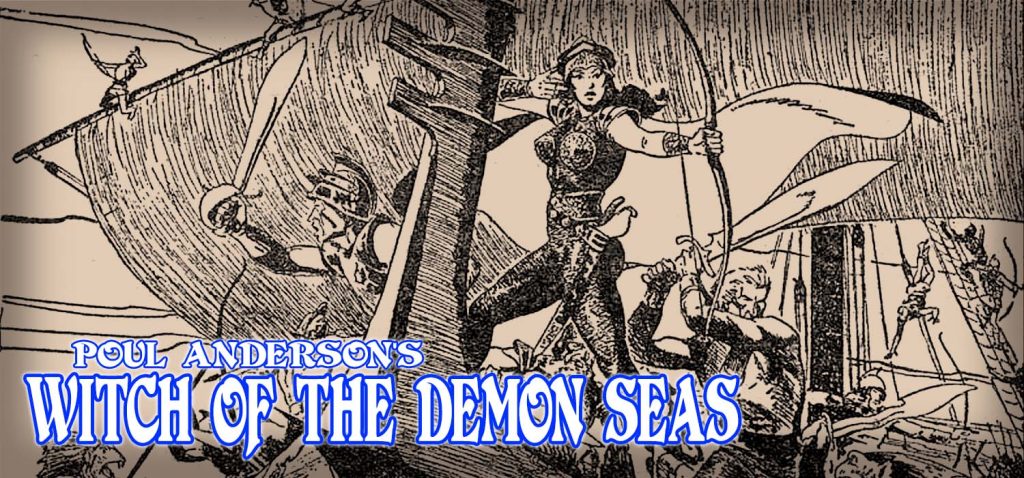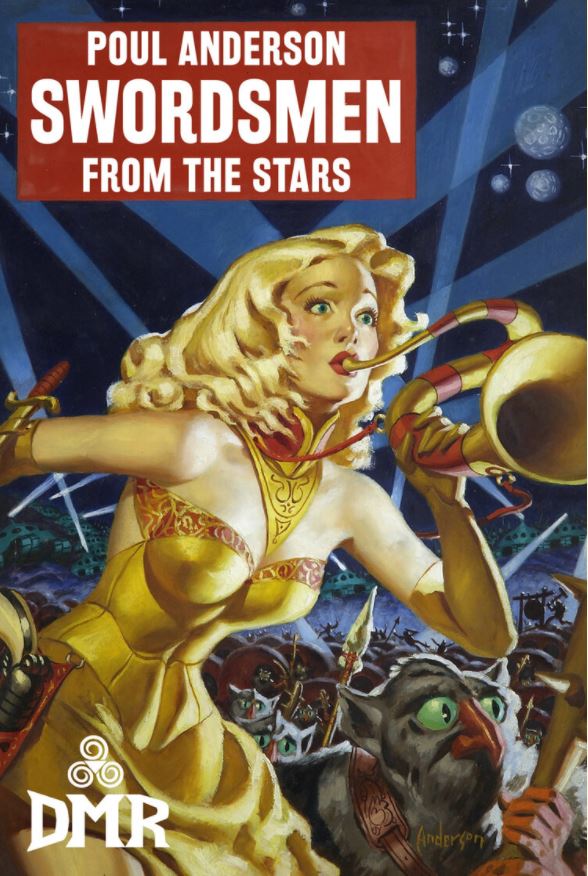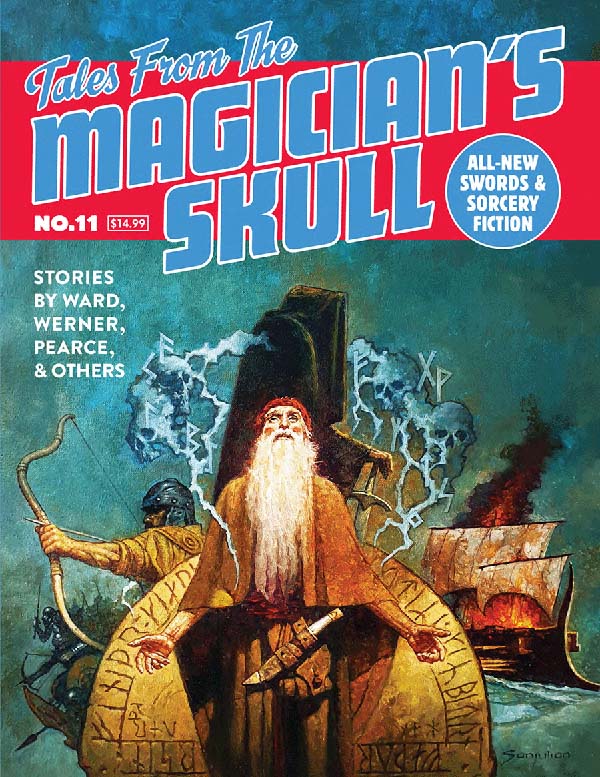Short Sorcery: Poul Anderson’s “Witch of the Demon Seas”
by Bill Ward
“Let us not use words meant to impress the ignorant among ourselves,” said Chryseis scornfully. “Every sorcerer knows there is nothing of heaven or hell about magic. It is but the imposition of a pattern on other minds. It creates, by control of the senses, illusions of lycanthropy or whatever else is desired, or it binds the subject by the unbreakable compulsion of a geas. But it is no more than that—one mind reaching through space to create what impressions it wills on another mind. Your devil-powder, or an ordinary sword or ax or fist, is more dangerous—if the fools only knew.”
Corun of Conahur, once prince of a conquered people, now pirate and rebel, has been captured and brought to Tauros, the seat of imperial sea power for the Thalassocracy of Archaea. Imprisoned, facing certain doom, he is offered a chance to preserve his life in the service of new masters, the sinister sorcerer Shorzon and his beautiful and terrible daughter, the witch Cryseis. As one of the few adventurers ever to return alive from the forbidden realm of the Sea of Demons, one who actually conversed with the mysterious inhuman Xanthi and lived to tell the tale, Corun is uniquely valuable to the sorcerer’s unrevealed plans. Thus begins Poul Anderson’s novella “Witch of the Demon Seas,” a straight-ahead blood and thunder quest over phosphorescent seas in a barbarian-crewed galley into ruined alien lands with the fate of an entire planet at stake.
Interestingly, when “Witch of the Demon Seas” premiered in 1951 in Planet Stories vol. 4 issue 10 it was one of two tales from the 25-year-old Poul Anderson in that issue, and was actually the cover story – yet it was published under the pseudonym A.A. Craig, the only time Anderson would use that name. The other story, Tiger by the Tail, featured the debut of the ‘James Bond in Space’ (although two years prior to Fleming’s Casino Royale) character that would be Anderson’s most famous, Flandry. But in the shifting culture of post-war genre publishing in those days, the star of sword-and-sorcery style pulp was waning, the bright future of an ascendant people was to be chronicled in the chrome of science fiction, the mecho-fetishistic trappings of the genre and its avowed forward vision apparently enough to elevate it in respectability above mere scribblings of fantastical entertainment, no matter how ultimately pulpish the roots of either. So A.A. Craig bylined “Witch,” twenty years were to pass before it ever saw a reprint,* and, unlike its Flandry sibling that would be the nucleus for an entire series of novels, it remains to this day but a tantalizing one-off adventure.
But what an adventure. Anderson’s gifts as a natural storyteller are on full display, the novella bursting with a youthful energy and tight pulp sensibility. “Witch of the Demon Seas” has a Leigh Brackett feel to it, perhaps not least because it is technically sword-and-planet – it was appearing in Planet Stories afterall! Reminiscent to my mind of her stories from the late ’40s “The Moon that Vanished” and “The Sea-Kings of Mars” (later expanded into the classic novel The Sword of Rhiannon), Anderson’s world contains odd human cultures, mysterious aliens, lost civilizations, and super-science power. The distinctively Anderson feel comes from his love of history. This alien ocean world of archipelago kingdoms is modeled on the ancient Mediterranean, a natural inspiration for a polyglot world of multi-cultural intermingling, and Anderson’s coined proper nouns not only sound right to the ear, but evoke their historical cultural analogs Robert E. Howard-style. Tauros, Archaea, Isseria, Umlotu, Conahur, the Zurian Sea, Serapolis, Iliontic Bay – the master trick of taking a cutting from our own history and growing a fantastical seedling from it is surely one of the most potent world-building techniques in secondary world fiction.
Especially if that secondary world is the backdrop for short fiction. Anderson’s novella moves directly to the point, parceling out just enough world-building and characterization to add relish to his plot, sliding along in smooth and muscular fashion in such a way that it feels half its actual length. Not for nothing has the novella been called the ideal medium for sword-and-sorcery, and anyone who admires the skill of the juggler on the tightrope can see the same precision in the craftsmanship of well-wrought pulp adventure.
“Beyond the hull, the sea was an arabesque of luminescence, delicate traceries of shifting white light out to the glowing horizon. The cold fire streamed from the ship’s bows and whirled in her wake, the hull dripped liquid flame.”
Rumors are that the Sea of Demons harbors beds of gripping seaweed that hold fast to any ship that dare the voyage. The reality, as Corun knows from past experience and his new master and companions find out, is much worse. The Xanthi, amphibious or reptilian beings that somehow share this world with humanity, have staked out the Sea of Demons as their own, and the ancient remnants of the old world human civilizations the Xanthi emerged from the deep to annihilate still litter the run down islands of the creature’s domain. Into this realm, the sorcerer Shorzon leads his expedition – a geased crew of blue-skinned Umlotuan seadogs with Corun in overall command. Corun, striking a deal to escape execution – whether from an Archaean headsman or the monstrous Erinye kept as a pet by Cryseis – gradually comes more on board with the project, because he falls hard in love with the titular witch of the story, beautiful, mercurial, and vicious Cryseis.
The wonderfully descriptive sea journey culminates in a brutal shipboard amphibious assault from the Xanthi, until the story moves into the dark, mist-shrouded home of the Xanthi themselves for the final bloody and explosive resolution. The sorcerer and the witch gain their diplomatic audience with the leader-caste of the inhuman creatures, and their true, despicable plans are overheard by Corun, who races into action to bring the whole thing down around everyone’s ears. In a bombastic and heart-pumping climax, the Brackett-style Venusian Odyssey veers into the mud and blood of Howard – Corun (the name is no accident) even taking on the deadly griffon-like pet of the woman for whom his love has inverted into hate. And, believe it or not, there’s even a happy ending, an unexpected eucatastrophe saved for the very last page.
“Witch of the Demon Seas,” has been described as sword-and-sorcery with enough science fiction flavoring to make it palatable to editors wanting to distance themselves from ax-wielding brutes in loincloths. While true on some level, the nature of magic and manipulation in Corun’s world is actually central to the plot – the ‘rational’ elements of the tale are no more mere window dressing than sorcery itself would be in pure fantasy. You might even say the very theme of the novella is all about seeing through illusions – not only does Corun discover that magic is more akin to psychological illusion but, over and over, more truths are revealed, whether it be something simple like the geased crew having their ‘magical’ blinders removed, or Corun himself actually coming to an accord with the political realities of his world that lets him finally set aside the rage and ego that launched his piratical career and strive for something more beneficial for his people, there are many instances of dramatic turnabout in this ostensibly simple adventure. But, make no mistake, it is also just that – a simple adventure of the very best kind, a fun-first, compelling, and exuberantly told pulp-infused romp from that indomitable half-Viking, half-Astronaut, Poul Anderson.
*reprinted in Robert Hoskins’ 1970 anthology Swords Against Tomorrow under the far inferior title of “Demon Journey.” Recently DMR Books has collected “Witch of the Demon Seas” and two other Anderson sword-and-planet adventures from Planet Stories (all appearing in 1951) in Swordsmen From the Stars.








